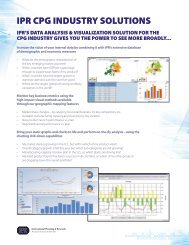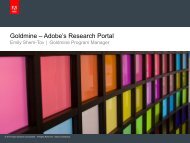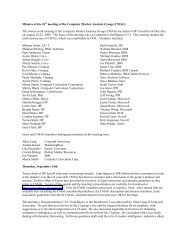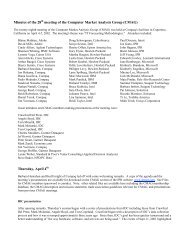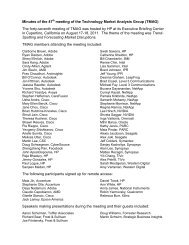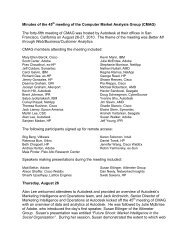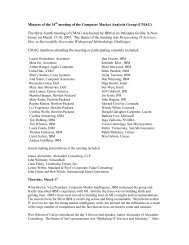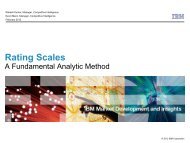Create successful ePaper yourself
Turn your PDF publications into a flip-book with our unique Google optimized e-Paper software.
Minutes of the 49th meeting of the Technology Market Analysis Group (<strong>TMAG</strong>)<br />
The forty-ninth meeting of <strong>TMAG</strong> was hosted by Adobe at their corporate headquarters in San<br />
Jose, California on August 22-23, 2012. The theme of the meeting was MI Operating Models<br />
and Processes: Best Practices.<br />
<strong>TMAG</strong> members attending the meeting included:<br />
Abbey Bowman, ABBYY USA<br />
Yvette Abatecola, Adobe<br />
Meira Chefitz, Adobe<br />
Ryan Dietzen, Adobe<br />
Karen Draper, Adobe<br />
Deanna Graham, Adobe<br />
Jane Hext, Adobe<br />
Kathryn Lewark, Adobe<br />
Julie Heiser, Adobe<br />
Julie McEntee, Adobe<br />
Teri Mortola, Adobe<br />
Susan Walker, Adobe<br />
David Welch, Adobe<br />
Claiborne Brown, Adobe<br />
Balazs Korom, Adobe<br />
Nick Lyon, Adobe<br />
Daya Nadamuni, Adobe<br />
Isil Clark, Agilent<br />
Margot Topp, Agilent<br />
Jim Slevin, AMD<br />
Pras Chaudhuri, ArcInsight<br />
Alan Lee, Autodesk<br />
Ashley Martin, Autodesk<br />
Jessica Raedler, Autodesk<br />
Lena Redko, Autodesk<br />
Yvonne Shu, Autodesk<br />
Stephen Heffernan, CareFusion<br />
Jocelyn Ochinang, CareFusion<br />
Daniela Bayer, Cisco<br />
Mary Ellen Bercik, Cisco<br />
Jane Chou, Cisco<br />
Engeli Gagni, Cisco<br />
Nolan Kuan, Cisco<br />
Theresa Kushner, Cisco<br />
Shawn Reeves, Cisco<br />
Madhu Subramanian, Cisco<br />
Martin Lee, CSC<br />
Vibhooti Juneja, CyberSource<br />
Doug Schwegman, CyberSource<br />
Jack Lamey, Epson<br />
Parm Uppal, ex-Xilinx<br />
Jimmy Gonzales, HP<br />
Sanjeev Madan, HP<br />
Matt Miller, HP<br />
Demian Straka, HP<br />
Jose Tormo, HP<br />
Paul Logue, HP<br />
Kevin Mann, IBM<br />
Lisa Sammon, Intel<br />
Stoyan Radov, Intel<br />
Brent Johnson, <strong>IPR</strong><br />
Jeff Young, <strong>IPR</strong><br />
Gerard Cote, Level 3 Communications<br />
Regina Ramos, NetApp<br />
Yuki Hoashi, Nokia<br />
Lee Hirsch, NVIDIA<br />
Shveta Saggar, NVIDIA<br />
Inga Vailionis, Omnicell<br />
Kathy Jarvis, PARC (Xerox)<br />
Alex Jukl, Seagate<br />
Alexis Jacobson, Seagate<br />
Jeff Coldani, Symantec<br />
Heli Erickson, Symantec<br />
Mei Yick, Symantec<br />
Chip Gale, Synopsys<br />
Matteo Recagni, Synopsys<br />
Alex Petrilli, TiVo<br />
Joanne McKinney, Visa
<strong>TMAG</strong> 49 Hosted by Adobe in San Jose, California August 22-23, 2012<br />
The following participants signed up for remote access:<br />
Paul Teich, ex-AMD<br />
Robin Yarmovsky, ex-Sun<br />
Seyi Mclelland, FICO<br />
Catherine Sheldon, HP<br />
Anna James, National Instruments<br />
Dolly Goulart, Qualcomm<br />
Jessica Sneed, Synopsys<br />
Rebecca Burr, Xilinx<br />
Outside speakers making presentations during the meeting and their guests included:<br />
Shari Morwood, Ideas to Go<br />
Adam Hansen, Ideas to Go<br />
Andy Blackburn, Cisco<br />
Peter Meyers, Stand & Deliver<br />
Wednesday, August 22<br />
Marcia Pizzo, Stand & Deliver<br />
Lucas Meyers, Stand & Deliver<br />
Rob Beaedeker, Stand & Deliver<br />
Robert Moran, Brunswick Group<br />
David Welch of Adobe welcomed attendees to <strong>TMAG</strong> 49 with some opening remarks, in which he<br />
shared some <strong>TMAG</strong> history through his personal experiences with the group. He was followed by<br />
Jeff Young of <strong>IPR</strong>, who introduced the day’s first speakers, Shari Morwood and Adam Hansen of<br />
Ideas to Go. Shari and Adam’s presentation was entitled “From Creative Chaos to Strategic<br />
Momentum: The Secret to New Ideas that Win in the Marketplace”. During their session, they led<br />
attendees through a series of interactive exercises to illustrate techniques for assumption busting;<br />
nurturing new ideas, and extracting value from the absurd.<br />
After a short break, <strong>TMAG</strong> members introduced themselves to the group. As part of the<br />
introductions, members were asked to share one of the most unusual things they have done in their<br />
lives. <strong>TMAG</strong> attendees have engaged in a variety of noteworthy activities – one member spoke of<br />
having a gun pulled on his head by someone who didn’t like the music he was playing; other<br />
interesting experiences included participating in the opening and closing ceremonies for the 1984<br />
Summer Olympics; working at a crocodile farm; almost killing Julia Child; and attending a launch<br />
party at the Playboy Mansion.<br />
Following the member introductions, Engeli Gagni of Cisco introduced the day’s next speaker, Andy<br />
Blackburn of Cisco. Andy’s presentation was entitled “Marketing by the Numbers: Cisco’s<br />
Knowledge-Based Approach”. During his session, Andy outlined the structure and engagement<br />
model for Cisco’s Strategic Marketing Organization; he provided examples of market opportunity<br />
planning engagements and described the process by which his team helps Cisco optimize its<br />
marketing mix and exploit growth opportunities.<br />
Following lunch, the afternoon’s first speaker was Peter Meyers of Stand & Deliver. He was<br />
introduced by Theresa Kushner of Cisco. Peter’s presentation was entitled “High Performance<br />
Communication”. During his session, he focused on the three elements that provide the foundation<br />
for effective communications: Content, Delivery and State. In support of effective content, he<br />
shared a blueprint for planning effective communications, and a roadmap for structuring the<br />
associated message. He discussed the importance of congruence between body, voice and eyes in
<strong>TMAG</strong> 49 Hosted by Adobe in San Jose, California August 22-23, 2012<br />
the delivery of a message, and the role of physiology, beliefs and the “mind’s eye” in contributing to<br />
the state of the presenter. He illustrated his points through a variety of interactive exercises.<br />
Note: Stand & Deliver is holding a two-day "open" program in San Francisco on October 6-7 that<br />
will be based on the core principles that Peter Meyers introduced during his session. If you are<br />
interested, you can find out more at Speak to Inspire.<br />
After a short break, the afternoon’s next speaker was Robert Moran of Brunswick Group; his session<br />
was entitled “The Futures of Market Research”. He was introduced by Kevin Mann of IBM. Robert<br />
outlined forces that are disrupting commerce – and will eventually impact market research; the<br />
mega-trends that are shaping the future of the market research industry; a potential evolutionary<br />
path for market research; and a variety of potential future scenarios that may result, along with<br />
some current illustrative examples. He left the group with three questions to ponder: (1) How will<br />
“Big Knowledge” evolve in order to harness “Big Data”; (2) Where are crowds wise and where are<br />
they stupid; and (3) What are the limits to trend extrapolation in a time of rapid, discontinuous<br />
change?<br />
Wednesday’s program ended with the group’s first “speed dating” session, which was led by Ryan<br />
Dietzen of Adobe. This session was focused on MI Outputs, and featured brief presentations by<br />
representatives from <strong>TMAG</strong> member firms. Ryan and Julie Heiser of Adobe spoke on “Innovative<br />
Outputs” and shared examples of output from Adobe’s MarketSight program and delivery of<br />
research results via tablet; Steve Heffernan of CareFusion spoke on the Central Research Question<br />
as the “Pathway to Focused Outputs”; Jessica Raedler of Autodesk spoke on how her team presents<br />
output, how it promotes its output, and how it measures success; and Jack Lamey of Epson<br />
demonstrated an example of innovative presentation of market research results, utilizing an Excelbased<br />
simulator and a war gaming exercise, which he led the group through.<br />
After the meeting concluded for the day, attendees adjourned to Il Fornaio in San Jose, where <strong>IPR</strong><br />
hosted the group at a relaxing and convivial reception and dinner on Wednesday evening.<br />
Thursday, August 23<br />
Shari Morwood and Adam Hansen returned to the group to lead off day two with an interactive<br />
exercise that built on the examples they shared the previous day. They surveyed the group on their<br />
perspectives from the previous day’s session; elaborated on some of the key points; and wrapped<br />
up with some suggestions for applying the lessons learned during their session in the face of the<br />
day-to-day challenges we all face in our jobs and our lives. Shari and Adam invited the <strong>TMAG</strong><br />
membership to contribute to the discussion on ways of making time for innovation, by visiting their<br />
blog at www.ideastogo.com/blog-time-for-innovation.<br />
Jeff Young followed with a discussion of <strong>TMAG</strong> Business. He thanked our hosts at Adobe – and<br />
particularly Susan Walker – for their generous hospitality and the great experience we all had at<br />
<strong>TMAG</strong> 49. He then recognized the <strong>TMAG</strong> Agenda Committee – Jim Slevin of AMD, Jimmy Gonzales<br />
of HP, Ryan Dietzen of Adobe, Kevin Mann of IBM, and Theresa Kushner of Cisco – for their<br />
contributions to a very successful meeting. Jeff also thanked the <strong>TMAG</strong> Recruiting Committee -
<strong>TMAG</strong> 49 Hosted by Adobe in San Jose, California August 22-23, 2012<br />
Mary Ellen Bercik of Cisco, Robin Yarmovsky ex-Sun, Gerard Cote and Brad Crysel of Level 3<br />
Communications, Susan Walker of Adobe, Jim Slevin of AMD, Regina Ramos of NetApp, and Brent<br />
Johnson or <strong>IPR</strong> for their efforts which have helped to grow our membership to more than 330<br />
people and have produced the great turnout we have seen at our past couple of meetings. He gave<br />
a brief status overview of the prospective <strong>TMAG</strong> Europe group, and Kevin Mann shared an overview<br />
of a potential <strong>TMAG</strong> Bangalore group. Kevin asked U.S. <strong>TMAG</strong> members to encourage their India<br />
counterparts to participate in the group – anyone who is interested can contact Rakesh Kumar of<br />
IBM at rakeshd.kumar@in.ibm.com. Jim Slevin then shared an update on the Silicon Valley chapter<br />
of SCIP, which next meets on September 12 from 6:00-8:00 PM at Silicon Valley Bank. The title of<br />
the meeting is “Suffering Strategy! What We Don’t Know Hurts Us and What We Do Know Hurts<br />
Us”. For more information, go to SCIP Silicon Valley.<br />
Jeff then announced that Cisco has graciously offered to host the landmark <strong>TMAG</strong> 50 meeting in<br />
March 2013. Theresa Kushner indicated that she would investigate the use of Cisco’s TelePresence<br />
to augment the remote participation experience – including among prospective <strong>TMAG</strong> Europe and<br />
Bangalore members. The group considered three potential agenda themes:<br />
1. Competitive intelligence: How much and what do you need to know about your competitors? What’s the<br />
best way to research competitors? What can they find out about you in the process? This topic might be<br />
focused on a particular function – such as sales, product development, or M+A:<br />
a. Privacy/security issues? Especially given new methods of research, laws, EU issues and tracking<br />
(Theresa)<br />
b. Leveraging win/loss analysis, best practices (Inga)<br />
c. Finding information on companies that aren’t public or when you don’t have a known competitor<br />
(Claiborne) or when the competitor is also a “fellow traveler” or partner (Inga)<br />
d. Reading disruptive market conditions and their effects on your business (Mary Ellen)<br />
e. Drilling down on CI to gather qualitative information on the customer experience<br />
f. Co-opetition (Theresa)<br />
g. Strategic threats (Kevin) and opportunities (Pras) such as Amazon entering the cloud, Intel<br />
investing in cable<br />
h. Go-to-market analysis (Sean), competition among channel partners<br />
i. Case study: how is CI packaged, how does it filter up to decision making (Steve)? War game<br />
exercises?<br />
j. How are competitors segmented (Matteo)?<br />
k. How to differentiate along business models, not just by product (Chip)<br />
l. How are CI efforts organized internally? How to gather CI from internal sources and share it?<br />
(Yvonne)<br />
2. MI in new/difficult markets and with hard-to-recruit respondents:<br />
a. International markets (Theresa); particularly emerging markets (Pras); data analytics (Regina) and<br />
data quality (Pras) in emerging markets<br />
b. Emerging technology markets<br />
c. Use of mobile technologies to conduct research<br />
d. The “long tail” problem (Doug); what about the other “20” in an 80/20 view of the world (Kevin,<br />
Jimmy)? P+G has changed course on emerging markets (Theresa, Chip); would be good to hear<br />
from other industries (Mary Ellen). Emerging markets are not simply “mini” mature markets<br />
(Kevin)<br />
e. ROI on emerging markets (Claiborne)<br />
f. Finding the right countries to go to (Chip); innovation taking place within emerging/Africa<br />
markets (Stoyan); emerging market-specific products (Theresa)
<strong>TMAG</strong> 49 Hosted by Adobe in San Jose, California August 22-23, 2012<br />
g. How to manage MI functions within these markets (Theresa); would like to see case studies of<br />
difficult markets (Mary Ellen); we tend to take for granted the infrastructure that exists in mature<br />
markets<br />
h. Identifying and collaborating with secondary research vendors in emerging markets (Madhu)<br />
i. Research on younger people, the services market (Mary Ellen)<br />
3. Alternate ways of doing market research and/or acquiring customer information, i.e. what is new in Market<br />
Intelligence, Customer Data, Analytics, etc.<br />
a. Cascade Insight’s use of social media (Sean) to learn about competitors, partners<br />
b. Crowdsourcing (Chip): where/when it works and where/when it doesn’t<br />
c. Neurofocus (Pras) and neuro-research; Innerscope; ethics and privacy rights (Mary Ellen)<br />
d. Advertising Research Foundation study on neuro-research (Robert Moran)<br />
e. Evaluation of new/old techniques (Shveta); an objective look at this. Does it really work (Matteo)?<br />
f. Psychographic-type / subconscious methods (Jimmy); ethics and privacy rights (Mary Ellen,<br />
Daniela)<br />
g. Case studies of harvesting sales tools (Kevin)<br />
h. Changing roles, trends in incentives (Jack)<br />
i. Data and social media augmentation—e.g., resume mining for competitive insights (Theresa) and<br />
Twitter feeds (Pras)<br />
j. Quick quantitative research; demise of panel integrity; how to fight “let’s just do it on Facebook”<br />
(Teri)<br />
k. Measure budget trends / benchmarking (Inga)<br />
l. Other industries<br />
In successive rounds of voting, the group first eliminated topic #2 and then topic #1. Topic #3 –<br />
tentatively dubbed “All that is New in MI” will be the theme of <strong>TMAG</strong> 50. Daniela Bayer of Cisco,<br />
Chip Gale of Synopsys, Teri Mortola of Adobe, Stoyan Radov of Intel, and Jessica Raedler of<br />
Autodesk volunteered to participate in the Agenda Committee.<br />
Kevin Mann then presented a proposal for a <strong>TMAG</strong>-based training/certification program and led a<br />
brainstorming session to discuss ideas related to this proposal. Several <strong>TMAG</strong> members indicated<br />
that they would be interested in supporting the development of this program; others who are<br />
interested should contact Kevin at jkmann@us.ibm.com.<br />
After a short break, Demian Straka of HP presented a <strong>TMAG</strong> War Story, entitled “Five Strategies for<br />
Better Syndicated Research Contracts”. During his session, he advocated that those responsible for<br />
managing syndicated research (a) ride tandem; (b) use the internet; (c) isolate trouble and give<br />
special attention; (d) develop an “idea” person or team; and (e) measure usage.<br />
Kevin Mann then led the meeting’s second “speed dating” session, on MI Staffing and Outputs.<br />
During this session, Lee Hirsch of NVIDIA shared on overview of his team’s key MI responsibilities,<br />
with focus on a best practice – proactive communications and insight sharing. Inga Vailionis of<br />
Omnicell spoke on “The Quest for Insight”, which focuses on the search for differences, exceptions,<br />
anomalies, contradictions and paradoxes. David Welch of Adobe outlined the structure of his<br />
market intelligence organization and the key practice areas it is focused upon. Jim Slevin of AMD<br />
outlined the operating model of his organization, and described how he rationalized analytics<br />
responsibilities relative to other groups within AMD. He also provided an overview of his team’s<br />
deliverables and the service level agreement that supports these.
<strong>TMAG</strong> 49 Hosted by Adobe in San Jose, California August 22-23, 2012<br />
<strong>TMAG</strong> 49 concluded with small group discussions over lunch. Members were offered a choice of<br />
five discussion topics, and were asked to rank them according to their level of interest. Three<br />
discussion topics attracted a critical mass of interest:<br />
Forecasting: What are the forecast drivers you have found to be most relevant and meaningful to<br />
ensure an accurate forecast? What forecast methodologies have proven most effective for you?<br />
Do you utilize megatrend analysis, scenario planning, and/or early warning systems? How do you<br />
forecast market size/potential for new/emerging product categories? Attendees who signed up for<br />
this discussion included Jim Slevin, Mary Ellen Bercik, Jocelyn Ochinang, Julie McEntee, Lee Hirsch,<br />
Madhu Subramanian, Regina Ramos, Parm Uppal, Shveta Saggar, Matteo Recagni, Gerard Cote,<br />
Doug Schwegman, Robert Moran, and Jeff Young.<br />
Smartphone Study: Brent Johnson discussed more of the details behind the methodology and the<br />
results behind the smartphone study results that <strong>IPR</strong> shared with the group prior to the meeting, as<br />
well as considerations that need to be addressed when translating survey results into expectations<br />
of buyer behavior. Attendees who signed up for this discussion included Joanne McKinney, Jack<br />
Lamey, Jane Hext, Matt Miller, Pras Chaudhuri, and Brent Johnson.<br />
Knowledge Management: Do <strong>TMAG</strong> member companies follow a systematic approach to<br />
knowledge management? What types of information are their knowledge management systems<br />
designed to share? What are the key deliverables to the organization? What are the most<br />
significant shortcomings inherent in their current implementations? Attendees who signed up for<br />
this discussion included Yuki Hoashi, Chip Gale, Martin Lee, Ryan Dietzen, Jessica Raedler, Theresa<br />
Kushner, Jimmy Gonzales, Steve Heffernan, Inga Vailionis, and Ashley Martin.<br />
Kudos and thanks to Susan Walker and her team at Adobe for hosting such a successful meeting!



